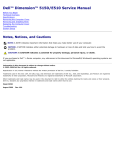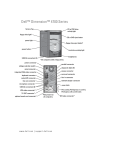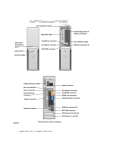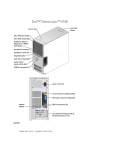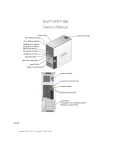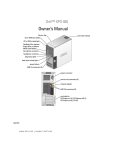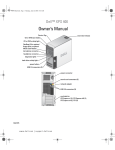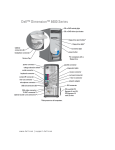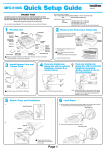Download Dell 5100C Laptop User Manual
Transcript
Dell™ Dimension™ 5100C Service Manual Before You Begin Technical Overview Specifications Removing the Computer Cover Removing and Installing Parts Replacing the Computer Cover Troubleshooting Tools System Setup Notes, Notices, and Cautions NOTE: A NOTE indicates important information that helps you make better use of your computer. NOTICE: A NOTICE indicates either potential damage to hardware or loss of data and tells you how to avoid the problem. CAUTION: A CAUTION indicates a potential for property damage, personal injury, or death. If you purchased a Dell™ n Series computer, any references in this document to Microsoft® Windows® operating systems are not applicable. Information in this document is subject to change without notice. © 2005 Dell Inc. All rights reserved. Reproduction in any manner whatsoever without the written permission of Dell Inc. is strictly forbidden. Trademarks used in this text: Dell, the DELL logo, and Dimension are trademarks of Dell Inc.; Intel, Pentium, Intel SpeedStep, a n d Celeron are registered trademarks of Intel Corporation; Microsoft and Windows are registered trademarks of Microsoft Corporation. Other trademarks and trade names may be used in this document to refer to either the entities claiming the marks and names or their products. Dell Inc. disclaims any proprietary interest in trademarks and trade names other than its own. April 2005 Rev. A00 Back to Contents Page Troubleshooting Tools Dell™ Dimension™ 5100C Service Manual Dell Diagnostics System Lights Diagnostic Lights Beep Codes Dell Diagnostics CAUTION: Before you begin any of the procedures in this section, follow the safety instructions in the Product Information Guide. When to Use the Dell Diagnostics If you experience a problem with your computer, perform the checks in this section and run the Dell Diagnostics before you contact Dell for technical assistance. NOTICE: The Dell Diagnostics works only on Dell™ computers. 1. Turn on (or restart) your computer. 2. When the DELL™ logo appears, press <F12> immediately. If you wait too long and the operating system logo appears, continue to wait until you see the Microsoft® Windows® desktop. Then shut down your computer and try again. 3. When the boot device list appears, highlight Boot to Utility Partition and press <Enter>. 4. When the Dell Diagnostics Main Menu appears, select the test you want to run (see "Dell Diagnostics Main Menu"). Dell Diagnostics Main Menu After the Dell Diagnostics loads and the Main Menu screen appears, click the button for the option you want. 1. Option Function Express Test Performs a quick test of devices. This test typically takes 10 to 20 minutes and requires no interaction on your part. Run Express Test first to increase the possibility of tracing the problem quickly. Extended Test Performs a thorough check of devices. This test typically takes an hour or more and requires you to answer questions periodically. Custom Test Tests a specific device. You can customize the tests you want to run. Symptom Tree Lists the most common symptoms encountered and allows you to select a test based on the symptom of the problem you are having. If a problem is encountered during a test, a message appears with an error code and a description of the problem. Write down the error code and problem description and follow the instructions on the screen. 2. If you cannot resolve the error condition, contact Dell. For information about contacting Dell, see your Owner's Manual. NOTE: The Service Tag for your computer is located at the top of each test screen. If you contact Dell, technical support will ask for your Service Tag. 3. If you run a test from the Custom Test or Symptom Tree option, click the applicable tab described in the following table for more information. Tab Function Results Displays the results of the test and any error conditions encountered. Errors Displays error conditions encountered, error codes, and the problem description. Help Describes the test and may indicate requirements for running the test. Configuration Displays your hardware configuration for the selected device. The Dell Diagnostics obtains configuration information for all devices from system setup, memory, and various internal tests, and it displays the information in the device list in the left pane of the screen. The device list may not display the names of all the components installed on your computer or all devices attached to your computer. Parameters Allows you to customize the test by changing the test settings. Close the test screen to return to the Main Menu screen. To exit the Dell Diagnostics and restart the computer, close the Main Menu screen. System Lights Your power button light and hard-drive activity light may indicate a computer problem. Power Light Problem Description Suggested Resolution Solid green Power is on, and the computer is operating normally. On the desktop computer, a solid green light indicates a network connection. No corrective action is required. Blinking green The computer is in the suspended state (Microsoft® Windows® 2000 and Windows XP). Press the power button, move the mouse, or press a key on the keyboard to wake the computer. Blinks green several times and then turns off A configuration error exists. Check the diagnostic lights to see if the specific problem is identified. Solid amber The Dell Diagnostics is running a test, or a device If the Dell Diagnostics is running, allow the testing to complete. on the system board may be faulty or incorrectly installed. Check the diagnostic lights to see if the specific problem is identified. If the computer does not boot, contact Dell for technical assistance (see your computer Owner's Manual for information about contacting Dell). Blinking amber A power supply or system board failure has occurred. Check the diagnostic lights to see if the specific problem is identified. Also, see "Power Problems" in your computer Owner's Manual. Solid green and a beep code during POST A problem was detected while the BIOS was executing. See "Beep Codes" for instructions on diagnosing the beep code. Also, check the diagnostic lights to see if the specific problem is identified. Solid green power light and no beep code and no video during POST The monitor or the graphics card may be faulty or Check the diagnostic lights to see if the specific problem is identified. See incorrectly installed. "Video and Power Problems" in your computer Owner's Manual. Solid green power light and no beep code but the computer locks up during POST An integrated system board device may be faulty. Check the diagnostic lights to see if the specific problem is identified. If the problem is not identified, contact Dell for technical assistance. See your computer Owner's Manual for information on how to contact Dell. Hard-Drive Activity Light Problem Description Suggested Resolution Solid green The hard-drive activity light is on when the computer reads data from or writes data to the hard drive. The light might also be on when a device such as a CD player is operating. No corrective action is required. Diagnostic Lights CAUTION: Before you begin any of the procedures in this section, follow the safety instructions in the Product Information Guide. To help you troubleshoot a problem, your computer has four lights labeled "1," "2," "3," and "4" on the front panel. When the computer starts normally, the lights flash. After the computer starts, all four lights display solid green. If the computer malfunctions, the color and sequence of the lights identify the problem. Light Pattern Problem Description Suggested Resolution The computer is in a normal "off" condition, has successfully booted to the operating system, or a possible pre-BIOS failure has occurred. Plug the computer into a working electrical outlet and press the power button. Also see "Power Problems" in your Owner's Manual. A possible processor failure has occurred. Contact Dell. For information about contacting Dell, see your Owner's Manual. Memory modules are detected, but a memory failure has occurred. l l l If you have two or more memory modules installed, remove the modules, reinstall one module, and then restart the computer. If the computer starts normally, reinstall an additional module. Continue until you have identified a faulty module or reinstalled all modules without error. If available, install properly working memory of the same type into your computer. If the problem persists, contact Dell (see your computer Owner's Manual for information about contacting Dell). A possible graphics card failure has occurred. l l l If the computer has a graphics card, remove the card, reinstall it and then restart the computer. If the problem still exists, install a graphics card that you know works and restart the computer. If the problem persists or the computer has integrated graphics, contact Dell (see your computer Owner's Manual for information about contacting Dell). A possible floppy or hard drive failure has occurred. Reseat all power and data cables and restart the computer. A possible USB failure has occurred. Reinstall all USB devices, check cable connections, and then restart the computer. No memory modules are detected. l l l Memory modules are detected, but a memory configuration or compatibility error exists. l l l A possible expansion card failure has occurred. 1. 2. 3. 4. Another failure has occurred. l l l l The computer is in a normal operating condition after POST. If you have two or more memory modules installed, remove the modules, reinstall one module, and then restart the computer. If the computer starts normally, reinstall an additional module. Continue until you have identified a faulty module or reinstalled all modules without error. If available, install properly working memory of the same type into your computer. If the problem persists, contact Dell (see your computer Owner's Manual for information about contacting Dell). Ensure that no special memory module/memory connector placement requirements exist (see "Memory"). Verify that the memory modules that you are installing are compatible with your computer (see "Memory"). If the problem persists, contact Dell (see your computer Owner's Manual for information about contacting Dell). Determine if a conflict exists by removing a card (not a graphics card) (see "Cards") and restarting the computer. If the problem persists, reinstall the card that you removed, remove a different card, and then restart the computer. Repeat this process for each card. If the computer starts normally, troubleshoot the last card removed from the computer for resource conflicts (see "Resolving Software and Hardware Incompatibilities" in your computer Owner's Manual). If the problem persists, contact Dell (see your computer Owner's Manual for information about contacting Dell). Ensure that the cables are properly connected to the system board from the hard drive, CD drive, and DVD drive. If there is an error message on your screen identifying a problem with a device (such as the floppy drive or hard drive), check the device to make sure it is functioning properly. The operating system is attempting to boot from a device (such as the floppy drive or hard drive); check system setup to ensure that the boot sequence is correct for the devices installed on your computer. If the problem persists, contact Dell (see your computer Owner's Manual for information about contacting Dell). None. NOTE: The diagnostic lights are not lit after the system successfully boots to the operating system. Beep Codes Your computer might emit a series of beeps during start-up if the monitor cannot display errors or problems. This series of beeps, called a beep code, identifies a problem. One possible beep code (code 1-3-1) consists of one beep, a burst of three beeps, and then one beep. This beep code tells you that the computer encountered a memory problem. Code Cause 1-1-2 Microprocessor register failure 1-1-3 NVRAM read/write failure 1-1-4 ROM BIOS checksum failure 1-2-1 Programmable interval timer failure 1-2-2 DMA initialization failure 1-2-3 DMA page register read/write failure 1-3 Video Memory Test failure 1-3-1 through 2-4-4 Memory not being properly identified or used 3-1-1 Slave DMA register failure 3-1-2 Master DMA register failure 3-1-3 Master interrupt mask register failure 3-1-4 Slave interrupt mask register failure 3-2-2 Interrupt vector loading failure 3-2-4 Keyboard Controller Test failure 3-3-1 NVRAM power loss 3-3-2 Invalid NVRAM configuration 3-3-4 Video Memory Test failure 3-4-1 Screen initialization failure 3-4-2 Screen retrace failure 3-4-3 Search for video ROM failure 4-2-1 No timer tick 4-2-2 Shutdown failure 4-2-3 Gate A20 failure 4-2-4 Unexpected interrupt in protected mode 4-3-1 Memory failure above address 0FFFFh 4-3-3 Timer-chip counter 2 failure 4-3-4 Time-of-day clock stopped 4-4-1 Serial or parallel port test failure 4-4-2 Failure to decompress code to shadowed memory 4-4-3 Math-coprocessor test failure 4-4-4 Cache test failure Back to Contents Page Back to Contents Page Before You Begin Dell™ Dimension™ 5100C Service Manual Getting Started Recommended Tools Turning Off Your Computer Before Working Inside Your Computer Getting Started This document provides procedures for removing and installing the components in your computer. Unless otherwise noted, each procedure assumes that the following conditions exist: l You have performed the steps in "Turning Off Your Computer" and "Before Working Inside Your Computer." l You have read the safety information in your Dell™ Product Information Guide. l A component can be replaced or—if purchased separately—installed by performing the removal procedure in reverse order. Recommended Tools The procedures in this document may require the following tools: l Small flat-blade screwdriver l Phillips #0 and #2 screwdrivers l Phillips #1 screwdriver l Flash BIOS update program floppy disk or CD Turning Off Your Computer NOTICE: To avoid losing data, save and close any open files and exit any open programs before you turn off your computer. 1. Shut down the operating system: a. Save and close any open files, exit any open programs, click the Start button, and then click Turn Off Computer. b. In the Turn off computer window, click Turn off. The computer turns off after the operating system shutdown process finishes. 2. Ensure that the computer and any attached devices are turned off. If your computer and attached devices did not automatically turn off when you shut down your operating system, press and hold the power button for 4 seconds. Before Working Inside Your Computer Use the following safety guidelines to help protect your computer from potential damage and to help ensure your own personal safety. CAUTION: Before you begin any of the procedures in this section, follow the safety instructions in the Product Information Guide. CAUTION: Handle components and cards with care. Do not touch the components or contacts on a card. Hold a card by its edges or by its metal mounting bracket. Hold a component such as a processor by its edges, not by its pins. NOTICE: Only a certified service technician should perform repairs on your computer. Damage due to servicing that is not authorized by Dell is not covered by your warranty. NOTICE: When you disconnect a cable, pull on its connector or on its strain-relief loop, not on the cable itself. Some cables have a connector with locking tabs; if you are disconnecting this type of cable, press in on the locking tabs before you disconnect the cable. As you pull connectors apart, keep them evenly aligned to avoid bending any connector pins. Also, before you connect a cable, ensure that both connectors are correctly oriented and aligned. NOTICE: To avoid damaging the computer, perform the following steps before you begin working inside the computer. 1. Turn off your computer. NOTICE: To disconnect a network cable, first unplug the cable from your computer and then unplug it from the network port or device. 2. Disconnect any telephone or network cables from the computer. 3. Disconnect your computer and all attached devices from their electrical outlets, and then press the power button to ground the system board. 4. Remove the computer stand, if it is attached. CAUTION: To guard against electrical shock, always unplug your computer from the electrical outlet before opening the cover. 5. Open the computer cover. NOTICE: Before touching anything inside your computer, ground yourself by touching an unpainted metal surface, such as the metal at the back of the computer. While you work, periodically touch an unpainted metal surface to dissipate any static electricity that could harm internal components. Back to Contents Page Back to Contents Page Replacing the Computer Cover Dell™ Dimension™ 5100C Service Manual CAUTION: Before you begin any of the procedures in this section, follow the safety instructions in the Product Information Guide. 1. Ensure that all cables are connected and folded out of the way. Pull the power cables toward you so that they do not get caught underneath the drives. 2. Ensure that no tools or extra parts are left inside the computer. 3. Install the cover: a. Align the bottom of the cover with the tabs located along the bottom of edge of the computer. b. Using the tabs as leverage, rotate the cover downward. c. Snap the cover into place by pulling back on the cover release latch, and then releasing the latch when the cover is properly seated. d. Ensure that the cover is seated correctly before moving the computer to the upright position. NOTICE: To connect a network cable, first plug the cable into the network port or device and then plug it into the computer. 4. Connect your computer and devices to electrical outlets, and turn them on. Back to Contents Page Back to Contents Page Removing the Computer Cover Dell™ Dimension™ 5100C Service Manual CAUTION: Before you begin any of the procedures in this section, follow the safety instructions in the Product Information Guide. 1. Follow the procedures in "Before You Begin." CAUTION: To guard against electrical shock, always unplug your computer from the electrical outlet before opening the cover. NOTICE: Ensure that sufficient space exists to support the removed cover—at least 30 cm (1 ft) of desk top space. NOTICE: Ensure that you are working on a level, protected surface to avoid scratching either the computer or the surface on which it is resting. 2. Lay your computer on its side with the computer cover facing up. 3. Pull back the cover latch release on the top panel. 4. Locate the three hinge tabs on the bottom edge of the computer. 5. Grip the sides of the computer cover and pivot the cover up, using the bottom hinges as leverage points. 6. Release the cover from the hinge tabs and set it aside in a secure location. Back to Contents Page Back to Contents Page Removing and Installing Parts Dell™ Dimension™ 5100C Service Manual Memory Fan Assembly Cards Processor Hard Drive Modem CD/DVD Drive Power Supply Floppy Drive (Optional) System Board Media Card Reader Front I/O Panel Heat-Sink Assembly Battery Memory You can increase your computer memory by installing memory modules on the system board. Your computer supports DDR2 memory. NOTE: Buffered memory is not supported on this computer. DDR2 Memory Overview DDR2 memory modules should be installed in pairs of matched memory size, speed, and technology. If the DDR2 memory modules are not installed in matched pairs, the computer will continue to operate, but with a slight reduction in performance. See the label on the module to determine the module capacity. NOTE: Always install DDR2 memory modules in the order indicated on the system board. The recommended memory configurations are: l A pair of matched memory modules installed in DIMM connectors 1 and 2 (white securing clips) or l A pair of matched memory modules installed in DIMM connectors 1 and 2 and another matched pair installed in DIMM connectors 3 and 4 (black securing clips) NOTICE: Do not install ECC memory modules. NOTE: If you install DDR2 667-MHz memory, the speed is reduced to 533 MHz. l If you install mixed pairs of DDR2 400-MHz (PC2-3200) and DDR2 533-MHz (PC2-4300) memory, the modules function at the speed of the slowest module installed. l Be sure to install a single memory module in DIMM connector 1, the connector closest to the processor, before you install modules in the other connectors. NOTE: Memory purchased from Dell is covered under your computer warranty. NOTICE: If you remove your original memory modules from the computer during a memory upgrade, keep them separate from any new modules that you may have, even if you purchased the new modules from Dell. If possible, do not pair an original memory module with a new memory module. Otherwise, your computer may not start properly. You should install your original memory modules in pairs either in DIMM connectors 1 and 2 or DIMM connectors 3 and 4. Addressing Memory With 4-GB Configurations Your computer supports a maximum of 4 GB of memory when you use two 2-GB DIMMs. Current operating systems, such as Microsoft® Windows® XP, can only use a maximum of 4 GB of address space; however, the amount of memory available to the operating system is less than 4 GB. Certain components within the computer require address space in the 4-GB range. Any address space reserved for these components cannot be used by computer memory. Installing Memory CAUTION: Before you begin any of the procedures in this section, follow the safety instructions in the Product Information Guide. NOTICE: To prevent static damage to components inside your computer, discharge static electricity from your body before you touch any of your computer's electronic components. You can do so by touching an unpainted metal surface on the computer chassis. 1. Follow the procedures in "Before You Begin." 2. Remove the computer cover. 3. Remove the CD/DVD drive, if installed. 4. Remove the optional Media Card Reader (or optional floppy drive), if installed. 5. Press out the securing clip at each end of the memory module connector. 6. Align the notch on the bottom of the module with the crossbar in the connector. NOTICE: To avoid damage to the memory module, press the module straight down into the connector while you apply equal force to each end of the module. 7. Insert the module into the connector until the module snaps into position. If you insert the module correctly, the securing clips snap into the cutouts at each end of the module. 8. Replace the computer cover. NOTICE: To connect a network cable, first plug the cable into the network port or device and then plug it into the computer. 9. Connect your computer and devices to electrical outlets, and turn them on. 10. Right-click the My Computer icon and click Properties. 11. Click the General tab. 12. To verify that the memory is installed correctly, check the amount of memory (RAM) listed. Removing Memory CAUTION: Before you begin any of the procedures in this section, follow the safety instructions in the Product Information Guide. NOTICE: To prevent static damage to components inside your computer, discharge static electricity from your body before you touch any of your computer's electronic components. You can do so by touching an unpainted metal surface on the computer chassis. 1. Follow the procedures in "Before You Begin." 2. Remove the computer cover. 3. Press out the securing clip at each end of the memory module connector. 4. Grasp the module and pull up. If the module is difficult to remove, ease the module back and forth to remove it from the connector. Cards CAUTION: Before you begin any of the procedures in this section, follow the safety instructions in the Product Information Guide. NOTICE: To prevent static damage to components inside your computer, discharge static electricity from your body before you touch any of your computer's electronic components. You can do so by touching an unpainted metal surface on the computer chassis. Your Dell™ computer provides the following slots for PCI Express cards: l One PCI Express x16 card slot l One PCI Express x1 card slot NOTE: The slots for the PCI Express x16 and PCI Express x1 cards are half-height slots. If you are installing or replacing a PCI Express card, follow the procedures in the next section. If you are removing but not replacing a card, see "Removing a PCI Express Card." If you are replacing a card, remove the current driver for the card from the operating system. Installing a PCI Express Card 1. Follow the procedures in "Before You Begin." 2. Remove the computer cover. 3. Pull up on the release tab on the card retention door from the inside to pivot the door open. Because the door is captive, it will remain in the open position. 4. If you are installing a new card, remove the filler bracket to create a card-slot opening. Then continue with step 6. 5. If you are replacing a card that is already installed in the computer, remove the card. If necessary, disconnect any cables connected to the card. Grasp the card by its top corners, and ease it out of its connector. 6. Prepare the card for installation. See the documentation that came with the card for information on configuring the card, making internal connections, or otherwise customizing it for your computer. CAUTION: Some network adapters automatically start the computer when they are connected to a network. To guard against electrical shock, be sure to unplug your computer from its electrical outlet before installing any cards. 7. Place the card in the connector and press down firmly. Ensure that the card is fully seated in the slot. 8. Prepare the card for installation. See the documentation that came with the card for information on configuring the card, making internal connections, or otherwise customizing it for your computer. CAUTION: Some network adapters automatically start the computer when they are connected to a network. To guard against electrical shock, be sure to unplug your computer from its electrical outlet before installing any cards. 9. If you are installing the card into the x16 card connector, position the card so the securing slot is aligned with the securing tab, and pull the securing tab. 10. Place the card in the connector and press down firmly. Ensure that the card is fully seated in the slot. 11. Before you close the card retention door, ensure that: l The tops of all cards and filler brackets are flush with the alignment bar. l 12. The notch in the top of the card or filler bracket fits around the alignment guide. Close the card retention door by snapping it into place to secure the card(s). NOTICE: Do not route card cables over or behind the cards. Cables routed over the cards can prevent the computer cover from closing properly or cause damage to the equipment. 13. Connect any cables that should be attached to the card. See the documentation that came with the card for information about the card cable connections. NOTICE: To connect a network cable, first plug the cable into the network port or device and then plug it into the computer. 14. Replace the computer cover, reconnect the computer and devices to electrical outlets, and then turn them on. 15. Install any drivers required for the card as described in the card documentation. Removing a PCI Express Card 1. Follow the procedures in "Before You Begin." 2. Remove the computer cover. 3. If necessary, disconnect any cables connected to the card. 4. Pull back the securing tab, grasp the card by its top corners, and then ease it out of its connector. 5. If you are removing the card permanently, install a filler bracket in the empty card-slot opening. If you need a filler bracket, contact Dell. NOTE: Installing filler brackets over empty card-slot openings is necessary to maintain FCC certification of the computer. The brackets keep dust and dirt out of your computer. 6. Secure the card(s) in the computer. NOTICE: To connect a network cable, first plug the cable into the network port or device and then plug it into the computer. 7. Replace the computer cover, reconnect the computer and devices to electrical outlets, and then turn them on. 8. Remove the card driver from the operating system. Hard Drive CAUTION: Before you begin any of the procedures in this section, follow the safety instructions located in the Product Information Guide. CAUTION: To guard against electrical shock, always unplug your computer from the electrical outlet before removing the cover. NOTICE: To avoid damage to the drive, do not set it on a hard surface. Instead, set the drive on a surface, such as a foam pad, that will sufficiently cushion it. NOTICE: If you are replacing a hard drive that contains data you want to keep, back up your files before you begin this procedure. Check the documentation for the drive to verify that it is configured for your computer. Removing a Hard Drive 1. Follow the procedures in "Before You Begin." 2. Remove the computer cover. 3. Press the blue tabs on either side of the guide bracket toward each other and slide the drive up and out of the computer. 4. Disconnect the power cable and the serial ATA data cable from the drive. Installing a Hard Drive 1. Remove the old hard drive. 2. Unpack the replacement hard drive, and prepare it for installation. 3. Check the documentation for the drive to verify that it is configured for your computer. NOTE: If your replacement hard drive does not have the plastic guide bracket attached, remove the bracket from the old drive by unsnapping it from the drive. Snap the bracket onto the new drive. 4. Connect the power cable and the serial ATA data cable to the drive. 5. Ensure that all connectors are properly cabled and firmly seated. 6. Slide the drive into place until you feel a click or feel the drive securely installed. 7. Replace the computer cover. NOTICE: To connect a network cable, first plug the cable into the network port or device and then plug it into the computer. 8. Connect your computer and devices to electrical outlets, and turn them on. See the documentation that came with the drive for instructions on installing any software required for drive operation. CD/DVD Drive CAUTION: Before you begin any of the procedures in this section, follow the safety instructions in the Product Information Guide. CAUTION: To guard against electrical shock, always unplug your computer from the electrical outlet before opening the cover. Removing a CD/DVD Drive 1. Follow the procedures in "Before You Begin." NOTICE: Do not pull the drive out of the computer by the drive cables. Doing so may cause damage to cables and the cable connectors. 2. Remove the computer cover. 3. Pull up on the drive release latch and slide the drive toward the back of the computer. 4. Carefully, so as not to damage the attached interface cable, lift the drive away from the computer. NOTE: The interface cable is held in place by the metal drive bracket and does not need to be removed from the drive. 5. Disconnect the interface cable from the interface cable connector on the system board. 6. Set the drive aside in a secure location. Installing a CD/DVD Drive 1. Unpack the drive and prepare it for installation. Check the documentation that accompanied the drive to verify that the drive is configured for your computer. If you are installing an IDE drive, configure the drive for the cable select setting. 2. Connect the interface cable to the interface cable connector on the system board. 3. Slide the drive into place until you feel a click or feel the drive securely installed. 4. Check all cable connections, and fold cables out of the way to provide airflow for the fan and cooling vents. 5. Replace the computer cover. 6. Connect your computer and devices to their electrical outlets, and turn them on. 7. See the documentation that came with the drive for instructions on installing any software required for drive operation. 8. Enter system setup and select the appropriate Drive option. 9. Verify that your computer works correctly by running the Dell Diagnostics. Floppy Drive (Optional) CAUTION: Before you begin any of the procedures in this section, follow the safety instructions located in the Product Information Guide. CAUTION: To guard against electrical shock, always unplug your computer from the electrical outlet before removing the cover. Removing a Floppy Drive 1. Follow the procedures in "Before You Begin." 2. Remove the computer cover. 3. Remove the CD/DVD drive, if installed. 4. Pull up on the drive release latch and slide the drive toward the back of the computer. 5. Carefully, so as not to damage the attached interface cable, lift the drive away from the computer. 6. Disconnect the interface cable from the system board. NOTE: The interface cable is held in place by the metal drive bracket and does not need to be removed from the drive. Installing a Floppy Drive NOTE: If the replacement or new floppy drive does not have the shoulder screws, use the screws in the drive-panel insert. 1. Follow the procedures in "Before You Begin." 2. Remove the computer cover. 3. Slide the drive into place until you feel a click or feel the drive securely installed. 4. Attach the interface cable to the system board. 5. Check all cable connections, and fold cables out of the way to avoid blocking the fan and cooling vents. 6. Replace the CD/DVD drive. 7. Replace the computer cover. NOTICE: To connect a network cable, first plug the cable in to the network port or device and then plug it in to the computer. 8. Connect your computer and devices to their electrical outlets, and turn them on. See the documentation that came with the drive for instructions on installing any software required for drive operation. 9. 10. Enter system setup and select the appropriate Drive option. Verify that your computer works correctly by running the Dell Diagnostics. Media Card Reader For information about using the Media Card Reader, see your Owner's Manual. CAUTION: Before you begin any of the procedures in this section, follow the safety instructions in the Product Information Guide. NOTICE: To prevent static damage to components inside your computer, discharge static electricity from your body before you touch any of your computer's electronic components. You can do so by touching an unpainted metal surface on the computer chassis. Removing a Media Card Reader 1. Follow the procedures in "Before You Begin." 2. Remove the computer cover. 3. Remove the CD/DVD drive, if installed. 4. Remove the hard drive. 5. Disconnect the data cable from the back of the Media Card Reader and from the Media Card Reader connector on the system board. 6. Pull up on the drive release latch and slide the Media Card Reader toward the back of the computer. Then, lift to remove the drive from the computer. Installing a Media Card Reader 1. Follow the procedures in "Before You Begin." 2. Remove the computer cover. NOTE: If necessary, remove the Media Card Reader screws. 3. Remove the Media Card Reader from its packaging and ensure that all the screws are included. 4. Slide the drive into place until you feel a click or feel the drive securely installed. 5. Reconnect the data cable on the back of the Media Card Reader to the front-panel connector on the system board. 6. Replace the CD/DVD drive. 7. Replace the computer cover. NOTICE: To connect a network cable, first plug the cable in to the network port or device and then plug it in to the computer. 8. Connect your computer and devices to their electrical outlets, and turn them on. See the documentation that came with the drive for instructions on installing any software required for drive operation. 9. 10. Enter system setup and select the appropriate Drive option. Verify that your computer works correctly by running the Dell Diagnostics. Heat-Sink Assembly CAUTION: Before you begin any of the procedures in this section, follow the safety instructions in the Product Information Guide. 1. Follow the procedures in "Before You Begin." 2. Remove the computer cover. 3. Remove the CD/DVD drive, if installed. 1 heat-sink assembly CAUTION: The heat-sink assembly can get very hot during normal operation. Be sure that the assembly has had sufficient time to cool before you touch it. 4. Remove the two screws from either side of the heat-sink assembly. NOTICE: After you remove the heat-sink assembly, lay the assembly on its side. Do not set the heat-sink assembly upright or touch the thermal interface to avoid damage to the thermal interface material on the underside. 5. Pivot the assembly toward the back of the computer and lift to remove. Fan Assembly CAUTION: Before you begin any of the procedures in this section, follow the safety instructions in the Product Information Guide. 1. Follow the procedures in "Before You Begin." 2. Remove the computer cover. 3. Remove the CD/DVD drive, if installed. CAUTION: The heat-sink assembly can get very hot during normal operation. Be sure that the assembly has had sufficient time to cool before you touch it. 4. Remove the heat-sink assembly. 5. Disconnect the fan power cable from the FAN connector on the system board. 1 fan assembly 2 fan cable connector 3 fan release tab Processor Removing the Processor NOTICE: Do not perform the following steps unless you are familiar with hardware removal and replacement. Performing these steps incorrectly could damage your system board. For technical service, see "Contacting Dell" in the Owner's Manual. CAUTION: Before you begin any of the procedures in this section, follow the safety instructions in the Product Information Guide. 1. Follow the procedures in "Before You Begin." CAUTION: To guard against electrical shock, always unplug your computer from the electrical outlet before opening the cover. 2. Open the computer cover. CAUTION: The heat-sink assembly can get very hot during normal operation. Be sure that the assembly has had sufficient time to cool before you touch it. NOTICE: Before touching anything inside your computer, ground yourself by touching an unpainted metal surface, such as the metal at the back of the computer. While you work, periodically touch an unpainted metal surface to dissipate any static electricity that could harm internal components. 3. Remove the heat-sink assembly. 4. Open the processor cover. NOTICE: Carefully remove the processor from the socket to avoid permanent damage to the processor. 5. To remove the processor from the socket, lift the processor vertically in one motion. Leave the release lever extended in the release position so that the socket is ready for the new processor. Installing the Processor NOTICE: Ground yourself by touching an unpainted metal surface on the back of the computer. 1. Unpack the new processor. NOTICE: You must position the processor correctly in the socket to avoid permanent damage to the processor and the computer when you turn on the computer. 2. If the release lever on the socket is not fully extended, move it to that position. 3. Align the pin-1 corners of the processor and socket. NOTICE: Socket pins are delicate. To avoid damage, ensure that the processor is aligned properly with the socket, and do not use excessive force when you install the process. Be careful not to touch or bend the pins on the system board. 4. Set the processor lightly in the socket and ensure that the processor is level in the socket. When the processor is positioned correctly, press it with minimal pressure to seat it. 5. When the processor is fully seated in the socket, close the processor cover. 6. Pivot the socket release lever back toward the socket and snap it into place to secure the processor. NOTICE: When you install the heat-sink assembly, do not touch the thermal interface to prevent damage to the thermal interface material on the interface. NOTICE: If you are not installing a processor upgrade kit from Dell, reuse the original heat-sink assembly when you replace the processor. If you installed a processor replacement kit from Dell, return the original heat-sink assembly and processor to Dell in the same package in which your replacement kit was sent. 7. Replace the fan assembly if you removed it. 8. Plug the fan cable into the FAN connector on the system board. 9. Install the heat-sink assembly. 10. Plug the power cable into the 12VPOWER connector on the system board. 11. Replace the computer cover. NOTICE: To connect a network cable, first plug the cable into the network port or device and then plug it into the computer. 12. Connect your computer and devices to electrical outlets, and turn them on. Modem CAUTION: Before you begin any of the procedures in this section, follow the safety instructions in the Product Information Guide. NOTICE: Before you remove or install the modem, make sure to disconnect all telephone and network cables from your computer. NOTICE: To prevent static damage to components inside your computer, discharge static electricity from your body before you touch any of your computer's electronic components. You can do so by touching an unpainted metal surface on the computer chassis. Replacing the Modem 1. Follow the procedures in "Before You Begin." 2. Remove the computer cover. 3. Remove the hard drive. NOTE: For easier access to the modem, it may be necessary to remove the power cable from the power connector on the system board. 4. Remove the existing modem: a. Disconnect the modem cable from the modem. b. Use a small Phillips screwdriver to remove the two screws that secure the modem to the system board, and set the screws aside. c. Pull straight up on the attached pull-tab to lift the modem out of its connector on the system board. NOTICE: The connectors are keyed to ensure correct insertion. If you feel resistance, check the connectors and realign the card. 5. 6. Install the new modem: a. Align the modem with the screw holes and press the modem into the connector on the system board. b. Connect the modem cable to the modem. c. Use a Phillips screwdriver to replace and tighten the two screws that secure the modem to the system board. Replace the computer cover. Replacing the External Modem Connector 1. Follow the procedures in "Before You Begin." 2. Remove the computer cover. 3. Remove the existing modem. NOTE: Note the routing of the modem cable as you remove the modem. You must route the cable properly when you replace the modem to prevent the cable from being pinched or crimped. 4. Remove the modem cable from the modem. 5. Remove the external modem connector: a. Remove the screw that secures the external modem connector. b. Slide the external modem connector away from the slot that holds the modem connector in place. c. Lift the modem cable and connector from the computer. 6. 7. To install a new modem cable and external modem connector: a. Attach the modem cable to the external modem connector. b. Align the external modem connector with the slot on the back on the computer. c. Replace the screw that secures the external modem connector in place. d. Carefully route the cable wire and reconnect the modem cable to the modem. Replace the computer cover. Power Supply Removing the Power Supply CAUTION: Before you begin any of the procedures in this section, follow the safety instructions in your Product Information Guide. 1. Follow the procedures in "Before You Begin." CAUTION: To guard against electrical shock, always unplug your computer from the electrical outlet before opening the cover. NOTICE: Before touching anything inside your computer, ground yourself by touching an unpainted metal surface, such as the metal at the back of the computer. While you work, periodically touch an unpainted metal surface to dissipate any static electricity that could harm internal components. 2. Disconnect the AC power cable from the power supply connector. 3. Open the computer cover. 4. Disconnect the DC power cables from the system board and the drives. 5. Remove the three power supply screws. 6. Slide the power supply approximately 1 inch toward the front of the computer. 7. Lift the power supply out of the computer. Replacing the Power Supply 1. Lower the power supply into the computer and slide the power supply toward the back of the computer. 2. Replace the three power supply screws. 3. Reconnect the DC power cables. 4. Replace the computer cover. 5. Connect the AC power cable to the power supply connector. NOTICE: To connect a network cable, first plug the cable into the network port or device and then plug it into the computer. 6. Connect your computer and devices to electrical outlets, and turn them on. System Board Removing the System Board CAUTION: Before you begin any of the procedures in this section, follow the safety instructions in your Product Information Guide 1. Follow the procedures in "Before You Begin." CAUTION: To guard against electrical shock, always unplug your computer from the electrical outlet before opening the cover. 2. Open the computer cover. NOTICE: Before touching anything inside your computer, ground yourself by touching an unpainted metal surface, such as the metal at the back of the computer. While you work, periodically touch an unpainted metal surface to dissipate any static electricity that could harm internal components. 3. Remove the power supply, any installed cards, and any components that restrict access to the system board. 4. Disconnect all cables from the system board. 5. 6. Disconnect the modem cable and ground wire from the modem: a. Disconnect the modem cable from the modem. b. Use a size #1 screwdriver to remove the screws that secure the modem and ground wire to the system board, and set the screws aside. Before you remove the existing system board, visually compare the replacement system board to the existing system board to make sure that you have the correct part. 7. Remove the six screws that attach the system board to the bottom of the computer. 8. Lift the system board out of the computer. 9. Place the system board that you just removed next to the replacement system board. Replacing the System Board 1. Transfer components from the existing system board to the replacement system board: a. Remove the memory modules and install them on the replacement system board. CAUTION: The heat-sink assembly and processor package can get hot. To avoid burns, ensure that the assembly and package have had sufficient time to cool before you touch them. b. Remove the heat-sink assembly and processor package from the existing system board and transfer them to the replacement system board. c. Remove the modem from the existing system board and transfer it to the replacement system board. 2. Configure the settings of the replacement system board. 3. Set the jumpers on the replacement system board so that they are identical to the ones on the existing system board. NOTE: Some components and connectors on the replacement system board may be in different locations from corresponding connectors on the existing system board. 4. Orient the replacement system board by aligning the slots in the bottom of the board to the tabs on the computer. 5. Slide the system board down onto the pins. 6. Replace the screw that holds the system board down. 7. Reconnect the modem cable and ground wire to the modem: a. Reconnect the modem cable from the modem. b. Use a size #1 screwdriver to remove the screws securing the modem and ground wire to the system board, and set the screws aside. 8. Replace any components and cables that you removed from the system board. 9. Reconnect all cables to their connectors at the back of the computer. 10. Close the computer cover. NOTICE: To connect a network cable, first plug the cable into the network port or device and then plug it into the computer. 11. Connect your computer and devices to electrical outlets, and turn them on. Front I/O Panel CAUTION: Before you begin any of the procedures in this section, follow the safety instructions in your Product Information Guide. 1. Follow the procedures in "Before You Begin." CAUTION: To guard against electrical shock, always unplug your computer from the electrical outlet before opening the cover. 2. Open the computer cover. 3. Remove the power supply, any installed cards, and any components that restrict access to the system board. 4. Remove the system board. NOTE: Depending on your computer, you may have one or two screws that secure the front I/O panel. 5. Remove the two screws that hold the front I/O panel. 6. Pivot the I/O panel toward the back of the computer and lift to remove. 7. Disconnect any cables that are attached to the front I/O panel. 1 screws (2) 2 front I/O panel Battery CAUTION: Before you begin any of the procedures in this section, follow the safety instructions in the Product Information Guide. NOTICE: To prevent static damage to components inside your computer, discharge static electricity from your body before you touch any of your computer's electronic components. You can do so by touching an unpainted metal surface on the computer chassis. A coin-cell battery maintains computer configuration, date, and time information. The battery can last several years. If you have to repeatedly reset time and date information after turning on the computer, replace the battery. CAUTION: A new battery can explode if it is incorrectly installed. Replace the battery only with the same or equivalent type recommended by the manufacturer. Discard used batteries according to the manufacturer instructions. Replacing the Battery 1. Record all the screens in system setup so that you can restore the correct settings in step 11. 2. Follow the procedures in "Before You Begin." 3. Remove the computer cover. 4. Remove the hard drive. 5. Locate the battery socket (see "System Board Components"). NOTICE: If you pry the battery out of its socket with a blunt object, be careful not to touch the system board with the object. Ensure that the object is inserted between the battery and the socket before you attempt to pry out the battery. Otherwise, you may damage the system board by prying off the socket or by breaking circuit traces on the system board. 6. Remove the battery: a. Support the battery connector by pressing down firmly on the positive side of the connector. b. While supporting the battery connector, press the battery toward the positive side of the connector and pry it up out of the securing tabs on the negative side of the connector. NOTICE: To avoid damage to the battery connector, you must firmly support the connector while installing or removing a battery. 7. Install the new system battery. a. Support the battery connector by pressing down firmly on the positive side of the connector. b. Hold the battery with the "+" facing up, and slide it under the securing tabs on the positive side of the connector. c. Press the battery straight down into the connector until it snaps into place. 8. Replace the hard drive. 9. Replace the computer cover. NOTICE: To connect a network cable, first plug the cable into the network port or device and then plug it into the computer. 10. Connect your computer and devices to electrical outlets, and turn them on. 11. Enter system setup and restore the settings you recorded in step 1. 12. Properly dispose of the old battery. See the Product Information Guide for battery disposal information. Back to Contents Page Back to Contents Page Specifications Dell™ Dimension™ 5100C Service Manual Processor Drives Memory Connectors Computer Information Controls and Lights Video Power Audio Physical Expansion Bus Environmental Processor Processor types Intel® Pentium® 4 5XXX and 6XXX processors with Hyper-Threading technology Pentium D 8XXX dual core processors (no HyperThreading) Intel Celeron® D processors Level 1 (L1) cache 16 KB for Pentium 4 5XXX and 6XXX processors and Celeron D processors 2 x 16 KB for Pentium D 8XXX dual core processors Level 2 (L2) cache 1 MB for Pentium 4 5XXX processors 2 MB for Pentium 4 6XXX processors 2 x 1 MB for Pentium D 8XXX processors 128 KB for Celeron D processors (depending on your computer configuration) pipelined-burst, eight-way set associative, write-back SRAM Memory Type 400-MHz and 533-MHz DDR2 unbuffered SDRAM Memory connectors four Memory capacities 256-MB, 512-MB, 1-GB, or 2-GB non-ECC Maximum memory 4 GB NOTE: See "Addressing Memory With 4-GB Configurations" to verify the amount of memory available to the operating system. BIOS address F0000h Computer Information Chip set Intel 945G Express DMA channels eight Interrupt levels 24 BIOS chip (NVRAM) 4 Mb NIC integrated network interface capable of 10/100-Mbps communication System clock 800-MHz data rate Video Type Intel integrated Graphics Media Accelerator (GMA) 950 Audio Type Sigmatel STAC9220 Expansion Bus Bus type PCI Express x1 and x16 Bus speed PCI Express: x1 slot bidirectional speed: 500 MB/s x16 slot bidirectional speed: 8 GB/sec PCI Express: connector one x1 connector size 36 pins connector data width (maximum) one PCI Express lane PCI Express: connector one x16 connector size 164 pins connector data width (maximum) 16 PCI Express lanes Drives Externally accessible one slimline 3.5-inch media bay (for optional floppy drive or optional Media Card Reader) one slimline 5.25-inch drive bay Available devices Serial ATA drive, USB memory devices, CD drive, DVD drive, DVD+RW drive, DVD/CD-RW combo drive, DVD+/-RW, and Media Card Reader Internally accessible one bay for 1-inch high hard drive Connectors External connectors: IEEE 1394 one 6-pin powered back-panel connector one 6-pin powered front-panel connector data transfer speeds: 100Mb/s, 200Mb/s, and 400Mb/s Video 15-hole D-SUB connector USB two front-panel and five back-panel USB 2.0– compliant connectors data transfer speeds: 1.5Mb/s, 12Mb/s, and 480Mb/s Audio five back-panel connectors for line-in, line-out, microphone, surround sound, and center/Low Frequency Effects (LFE) channel back-panel S/PDIF connector front-panel miniature headphone connector for lineout front-panel microphone connector Network adapter RJ45 connector Modem RJ11 (MDC 1.5) connector System board connectors: IDE drive one 50-pin connector one 26-pin connector Serial ATA one 7-pin connectors Fan one 5-pin connectors PCI Express x1 36-pin connector PCI Express x16 164-pin connector USB 10-pin header for optional Media Card Reader (3.5inch bay device) MDC one 12-pin connector Front-panel audio one 10-pin header Front panel one 34-pin header Power one 2 x 12 connector Processor power one 2 x 2 connector IEEE 1394 one 2 x 5 header — always connected by cable to the front panel; supports front-panel IEEE1394 port Controls and Lights Power control push button Power light green light — Blinking green in sleep state; solid green for power-on state. amber light — Blinking amber indicates a problem with an installed device; solid amber indicates an internal power problem (see "Power Problems" in your computer Owner's Manual). Hard-drive access light green Link integrity light (on integrated network adapter) green light — A good connection exists between a 10-Mbps network and the computer. orange light — A good connection exists between a 100-Mbps network and the computer. off (no light) — The computer is not detecting a physical connection to the network. Activity light (on integrated network adapter) yellow blinking light Diagnostic lights four lights on the front panel (See "Dell Diagnostics" for an explanation of the diagnostic light codes.) Standby power light AUX_PWRLED on the system board Activity light (optional Media Card Reader) green blinking light Power DC power supply: Wattage 275 W Heat dissipation 460.7 BTU/hr Voltage (See the safety instructions in the Product Information Guide for important voltage setting information.) fixed-voltage power supply — 110 V at 50/60 Hz Backup battery manual selection and auto-sensing power supplies — 90 to 135 V at 50/60 Hz; 180 to 265 V at 50/60 Hz; 100 V at 50/60 Hz for Japanese computers 3-V CR2032 lithium coin cell Physical Height 31 cm (12.2 inches) Width 9.1 cm (3.6 inches) Depth 36.3 cm (14.3 inches) Weight 7.4 kg (16.4 lb) Environmental Temperature: Operating 10° to 35°C (50° to 95°F) Storage –40° to 65°C (–40° to 149°F) Relative humidity 20% to 80% (noncondensing) Maximum vibration: Operating 0.25 G at 3 to 200 Hz at 0.5 octave/min Storage 0.5 G at 3 to 200 Hz at 1 octave/min Maximum shock: Operating bottom half-sine pulse with a change in velocity of 50.8 cm/sec (20 inches/sec) Storage 27-G faired square wave with a velocity change of 508 cm/sec (200 inches/sec) Altitude: Operating –15.2 to 3048 m (–50 to 10,000 ft) Storage –15.2 to 10,668 m (–50 to 35,000 ft) Back to Contents Page Back to Contents Page System Setup Dell™ Dimension™ 5100C Service Manual Overview Entering System Setup System Setup Options Boot Sequence Clearing Forgotten Passwords Clearing CMOS Settings Overview Use system setup as follows: l To change the system configuration information after you add, change, or remove any hardware in your computer l To set or change a user-selectable option such as the user password l To read the current amount of memory or set the type of hard drive installed Before you use system setup, it is recommended that you write down the system setup screen information for future reference. NOTICE: Unless you are an expert computer user, do not change the settings for this program. Certain changes can make your computer work incorrectly. Entering System Setup 1. Turn on (or restart) your computer. 2. When the blue DELL™ logo appears, press <F2> immediately. If you wait too long and the operating system logo appears, continue to wait until you see the Microsoft® Windows® desktop. Then shut down your computer and try again. System Setup Screens The system setup screen displays current or changeable configuration information for your computer. Information on the screen is divided into three areas: the options list, active options field, and key functions. Option Field — This field contains information about each option. In this field you can view your current settings and make changes to your settings. Use the right- and left-arrow keys to highlight an option. Press <Enter> to make that selection active. Options List — This field appears on the left side of the system setup window. The field is a scrollable list containing features that define the configuration of your computer, including installed hardware, power conservation, and security features. Scroll up and down the list with the up- and down-arrow keys. As an option is highlighted, the Option Field displays more information about that option and the option's current and available settings. Press <Enter> to expand or contract each of the main option fields. Key Functions — This field appears below the Option Field and lists keys and their functions within the active system setup field. System Setup Options NOTE: Depending on your computer, BIOS version, and installed devices, the items listed in this section may not appear, or may not appear exactly as listed. System Processor Info Displays the following information for the processor installed in the system: Processor Type, Processor Clock Speed, Processor Bus Speed, Processor Cache Size, Processor ID number, whether the processor is Hyperthreading or Multiple Core Capable, and if the processor has 64-bit Technology. Memory Info Displays the amount of Installed Memory, Memory Speed, Memory Channel Mode, and a description of the Memory Technology. This option also displays a table that describes the memory size, whether the memory module is ECC capable, single or dual rank, type, and organization. PCI Info Displays the contents of each PCI slot. Date/Time Controls the system's internal calendar and clock. Determines the order in which the system searches for boot devices during system startup. Boot Sequence NOTE: If you insert a boot device and restart the computer, this option appears in the system setup menu. To boot from a USB memory device, select the USB device and move it so it becomes the first device in the list. Drives Diskette Drive Identifies and defines the floppy drive attached to the FLOPPY connector on the system board as Off, USB, Internal, or Read Only. Enables or disables a SATA device (such as a hard-drive). On (the default setting) enables the interface so that the device can be used. SATA 0 Displays the Controller type (SATA), Port number the drive is using, Drive ID number, Capacity, Link Speed, and whether the drive is controlled by the BIOS. Enables or disables an ATA device (such as a CD or DVD drive). On (the default setting) enables the interface so that the device can be used. PATA 0 Displays the Controller type (ATA), Port number the drive is using, Drive ID number, Capacity, Link Speed, and whether the drive is controlled by the BIOS. SATA Operation Identifies and defines the SATA modes. You can set the SATA controller to Normal or Combo mode. Onboard Devices Integrated NIC You can set the NIC to On (default), Off, or On w/ PXE. When the On w/ PXE setting is active (available only for the future boot process), the computer prompts the user to press <Ctrl><Alt><b>. Pressing this key combination causes a menu to display that allows you to select a method for booting from a network server. If a boot routine is not available from the network server, the computer attempts to boot from the next device in the boot sequence list. Integrated Audio Enables or disables the onboard audio controller. Front USB Ports Set to On (default) so that USB devices will be detected and supported in the operating system. The No Boot option enables a USB port, but it does not recognize a USB storage device. 1394 Controller Enables of disables the IEEE 1394 connections. On enables internal USB for FlexBay. USB for FlexBay NOTE: This USB option appears only if a FlexBay device is installed. Video Primary Video This setting specifies which video controller is primary when two video controllers are present on the computer. Video Memory Size Use this option to select 8 MB (default) or 1 MB of system memory for an integrated video controller. Performance HyperThreading If your computer processor supports Hyper-Threading, this option appears in the Options List. Multiple CPU Core This setting specifies whether more than one core is enabled. The performance of some applications may improve with an additional core enabled. Defaults to On (second core enabled). SpeedStep This field specifies whether Enhanced Intel® SpeedStep® Technology will be enabled for all supported processor(s) in the computer. l l l l HDD Acoustic Mode Bypass — Your computer does not test or change the current acoustics mode setting. Quiet (default) — The hard drive operates at its most quiet setting. Suggested — The hard drive operates at the level suggested by the drive manufacturer. Performance — The hard drive operates at its maximum speed. NOTE: Switching to performance mode may cause the drive to be noisier, but the drive performance is not affected. NOTE: Changing the acoustics setting does not alter your hard drive image. Security This section displays available system security options. Admin Password Displays the current status of the system setup password security feature and allows a new system setup password to be assigned and verified. System Password Displays the current status of the system's password security feature and allows a new system password to be assigned and verified. Password Changes This option locks the system password field with the setup password. When the field is locked, you can no longer disable password security by pressing <Ctrl><Enter> when the computer starts. Also, a valid Admin password is required to change the system password. Defaults to Unlocked. Execute Disable Enables or disables Execute Disable memory protection technology. On is the default setting. Power Management AC Recovery Determines what happens when AC power is restored to the computer. Sets the computer to automatically turn on. Choices are every day or every Monday through Friday. Auto Power On The default setting is Off. This feature does not work if you turn off your computer using a power strip or surge protector. Sets time to automatically turn on the computer. Auto Power Time Time is kept in a 24-hour format (hours:minutes). Change the start-up time by pressing the right- or left-arrow key to increase or decrease the numbers, or type numbers in both the date and time fields. This feature does not work if you turn off your computer using a power strip or surge protector. Suspend Mode The options are S1, a suspend state where the computer is running in a low-power mode, and S3, a standby state where the power is reduced or turned off for most components, however, system memory remains active. Maintenance SERR DMI Message Some graphics cards require that the SERR DMI message be disabled. The default setting is On. Load Defaults This setting restores the computer's factory-installed default settings. Event Log Displays the system event log. POST Behavior Fastboot When set to On (default), your computer starts more quickly because it skips certain configurations and tests. Numlock Key This option involves the rightmost bank of keys on your keyboard. When set to On (default), this option activates the numeric and mathematical features shown at the top of each key. When set to Off, this option activates the cursor-control functions labeled on the bottom of each key. POST Hotkeys This option allows you to specify the function keys to display on the screen when the computer starts. Keyboard Errors This option enables or disables keyboard error reporting when the computer starts. Boot Sequence This feature allows you to change the boot sequence for devices. NOTICE: If you modify any boot sequence settings, save the new settings to avoid losing the changes. Option Settings l Diskette Drive — The computer attempts to boot from the floppy drive. If the floppy disk in the drive is not bootable, if no floppy disk is in the drive, or if there is no floppy drive installed in the computer, the computer generates an error message. l Hard Drive — The computer attempts to boot from the primary hard drive. If no operating system is on the drive, the computer generates an error message. l CD Drive — The computer attempts to boot from the CD drive. If no CD is in the drive, or if the CD has no operating system, the computer generates an error message. l USB Flash Device — Insert the memory device into a USB port and restart the computer. When F12 = Boot Menu appears in the upper-right corner of the screen, press <F12>. The BIOS detects the device and adds the USB flash option to the boot menu. NOTE: To boot to a USB device, the device must be bootable. To make sure that your device is bootable, check the device documentation. Changing Boot Sequence for the Current Boot You can use this feature, for example, to restart your computer to a USB device such as a floppy drive, or memory key. 1. If you are booting to a USB device, connect the USB device to a USB connector (see "Front View." 2. Turn on (or restart) your computer. 3. When F2 = Setup, F12 = Boot Menu appears in the upper-right corner of the screen, press <F12>. If you wait too long and the operating system logo appears, continue to wait until you see the Microsoft Windows desktop. Then shut down your computer through the Start menu and try again. The Boot Device Menu appears, listing all available boot devices. 4. Select a device and press <Enter>. For example, if you are booting to a USB memory key, highlight USB Flash Device and press <Enter>. NOTE: To boot to a USB device, the device must be bootable. To make sure your device is bootable, check the device documentation. NOTE: You can also change the boot sequence using the Boot Sequence options in the System Setup Options. Changing Boot Sequence for Future Boots 1. Enter system setup. 2. Press the arrow keys to highlight the Boot Sequence menu option and press <Enter> to access the menu. NOTE: Write down your current boot sequence in case you want to restore it. 3. Press the up- and down-arrow keys to move through the list of devices. 4. Press the spacebar to enable or disable a device (enabled devices have a checkmark). 5. Press the <u> key or the <d> key to move a selected device up or down the list. Clearing Forgotten Passwords CAUTION: Before you begin any of the procedures in this section, follow the safety instructions in the Product Information Guide. 1. Follow the procedures in "Before You Begin." 2. To clear the password, remove the jumpers from pins 1 and 2. 3. Replace the computer cover. 4. Connect your computer and monitor to electrical outlets, and turn them on. 5. After the Microsoft® Windows® desktop appears on your computer, shut down the computer. 6. Turn off the monitor and disconnect it from the electrical outlet. 7. Disconnect the computer power cable from the electrical outlet, and press the power button to ground the system board. 8. Remove the computer cover. 9. Locate the 3-pin password jumper (PSWD) on the system board and attach the jumper to pins 1 and 2 to re-enable the password feature. 10. Replace the computer cover. NOTICE: To connect a network cable, first plug the cable into the network port or device and then plug it into the computer. 11. Connect your computer and devices to electrical outlets, and turn them on. Clearing CMOS Settings CAUTION: Before you begin any of the procedures in this section, follow the safety instructions in the Product Information Guide. 1. Follow the procedures in "Before You Begin." 2. Remove the computer cover. 3. Remove the hard drive. 4. Reset the current CMOS settings: a. Locate the 3-pin CMOS jumper (RTCRST) on the system board. b. Remove the jumper plug from pins 2 and 3. c. Place the jumper plug on pins 1 and 2 and wait approximately 5 seconds. d. Replace the jumper plug on pins 2 and 3. 5. Replace the hard drive. 6. Replace the computer cover. NOTICE: To connect a network cable, first plug the cable into the network port or device and then plug it into the computer. 7. Connect your computer and devices to electrical outlets, and turn them on. Back to Contents Page Back to Contents Page Technical Overview Dell™ Dimension™ 5100C Service Manual Front View Back View Inside View of Your Computer System Board Components Power Supply DC Connector Pin Assignments Front View NOTE: The front-panel door does not close when you are using certain Flash Media or IEEE 1394, USB, or headphone connectors. 1 CD/DVD drive eject button Press this button to eject a CD/DVD from the drive. 2 CD/DVD driveactivity light The drive activity light is on when the computer reads data from the CD or DVD drive. 3 USB 2.0 connectors (2) Use the front USB connectors for devices that you connect occasionally, such as joysticks or cameras (see "System Setup" for more information on booting to a USB device). It is recommended that you use the back USB connectors for devices that typically remain connected, such as printers, keyboards, and mice, or for bootable USB devices, which may not function properly if attached to the front connectors. 4 IEEE 1394 connector Attach high-speed serial multimedia devices, such as digital video cameras. It is recommended that you use the back IEEE 1394 connector for devices that typically remain connected, such as external hard drives and other storage devices. 5 vents For adequate cooling, do not block any of the vents. NOTICE: Ensure that there is a minimum of two inches of space between all vents and any object near these vents. NOTICE: Do not lift or carry the computer by the vents to avoid damage to the computer. NOTICE: Keep the vent area clean and dust-free to ensure that the computer is adequately ventilated. Use only a dry cloth to clean the vent area to avoid water damage to the computer. 6 power button Press this button to turn on the computer. NOTICE: To avoid losing data, do not use the power button to turn off the computer. Instead, perform an operating system shutdown. 7 power light The power light illuminates and blinks or remains solid to indicate different states: ¡ ¡ ¡ ¡ No light — The computer is turned off. Steady green — The computer is in a normal operating state. Blinking green — The computer is in a power-saving state. Blinking or solid amber — See "Power Problems" in your computer Owner's Manual. 8 front-panel door release button Press this button to access the front-panel connectors. 9 microphone connector Use the pink microphone connector to attach a personal computer microphone for voice or musical input into a sound or telephony program. On computers with a sound card, the microphone connector is on the card. 10 headphone connector Use the green headphone connector to attach headphones. 11 FlexBay Use the Flexbay for an optional floppy drive or Media Card Reader. 12 diagnostic lights For more information on what each diagnostic light means, see "Diagnostic Lights." 13 front-panel door This panel covers the CD/DVD drive and the optional Media Card Reader or floppy drive. Back View 1 voltage selection switch (may not be available on all computers) See the safety instructions in the Product Information Guide for more information. 2 power connector Insert the power cable. 3 back panel connectors Plug USB and other devices into the appropriate connector. 4 card slots Access connectors for any installed PCI Express cards. 1 link integrity light l l l 2 network adapter connector Green — A good connection exists between a 10-Mbps network and the computer. Orange — A good connection exists between a 100-Mbps network and the computer. Off — The computer is not detecting a physical connection to the network. To attach your computer to a network or broadband device, connect one end of a network cable to either a network port or your network or broadband device. Connect the other end of the network cable to the network adapter connector on the back panel of your computer. A click indicates that the network cable has been securely attached. NOTE: Do not plug a telephone cable into the network connector. On computers with a network connector card, use the connector on the card. It is recommended that you use Category 5 wiring and connectors for your network. If you must use Category 3 wiring, force the network speed to 10 Mbps to ensure reliable operation. 3 network activity light Flashes a yellow light when the computer is transmitting or receiving network data. A high volume of network traffic may make this light appear to be in a steady "on" state. 4 modem connector Use the modem connector to connect your computer to the Internet. 5 surround sound connector Use the black surround sound connector to attach multichannelcapable speakers. 6 line-in connector Use the blue line-in connector to attach a record/playback device such as a cassette player, CD player, or VCR. 7 line-out connector 8 microphone/sidesurround sound connector On computers with a sound card, use the connector on the card. Use the green line-out connector to attach headphones and most speakers with integrated amplifiers. On computers with a sound card, use the connector on the card. Use the pink and silver connector to attach a personal computer microphone for voice or musical input into a sound or telephony program. On computers with a sound card, the microphone connector is on the card. The side-surround output provides enhanced surround audio for computers with 7.1 speakers. 9 center/LFE connector LFE (Low Frequency Effects) Audio channel found in digital surround sound audio schemes that carries only low frequency information of 80 Hz and below. The LFE channel drives a subwoofer to provide extremely low bass extension. Systems not using subwoofers can shunt the LFE information to the main speakers in the surround sound set-up. 10 S/PDIF connector This connector is used to transmit digital audio without going through an analog audio conversion process. 11 VGA connector If your monitor has a VGA connector, plug it into a VGA connector on the computer. Use this VGA connector if you do not have a PCI Express video card. 12 USB 2.0 connectors (5) Use the back USB connectors for devices that typically remain connected, such as printers and keyboards. It is recommended that you use the back USB connectors for devices that typically remain connected, such as printers, keyboards, and mice, or for bootable USB devices, which may not function properly if attached to the front connectors. 13 IEEE 1394 connector Attach high-speed serial multimedia devices, such as digital video cameras. Inside View of Your Computer CAUTION: Before you begin any of the procedures in this section, follow the safety instructions in the Product Information Guide. CAUTION: To guard against electrical shock, always unplug your computer from the electrical outlet before opening the cover. System Board Components Jumper Settings The jumper locations are shown below. Jumper Setting Description PSWD Password features are enabled. (default) Password features are disabled. RTCRST Real-time clock reset in normal operation. (default) Clear CMOS settings. Power Supply DC Connector Pin Assignments DC Power Connector P1 Pin Number Signal Name 18-AWG Wire 1 +3.3 VDC Orange 2 +3.3 VDC Orange 3 COM Black 4 +5 VDC Red 5 COM Black 6 +5 VDC Red 7 COM Black 8 POK* Gray 9 +5 VFB Purple 10 +12 VDC Yellow 11 +12 VDC* Yellow 12 +3.3 VDC Orange 13 +3.3 VDC Orange 14 -12 VDC Blue 15 COM Black 16 PS_ON* Blue 17 COM Black 18 COM Black 19 COM Black 20 N.C. N.C. 21 +5 VDC Red 22 +5 VDC Red 23 +5 VDC Red 24 COM Black *Use 22 AWG wire instead of 18 AWG. DC Power Connector P2 Pin Number Signal Name 18-AWG Wire 1 COM Black 2 COM Black 3 +12 VDC Yellow 4 +12 VDC Yellow DC Power Connector P3 Pin Number Signal Name 18-AWG Wire 1 +3.3 VDC Orange 2 COM Black 3 +5 VDC Red 4 COM Black 5 +12 VDC Yellow Back to Contents Page Back to Contents Page Dell™ Dimension™ 5100C Service Manual NOTE: A NOTE indicates important information that helps you make better use of your computer. NOTICE: A NOTICE indicates either potential damage to hardware or loss of data and tells you how to avoid the problem. CAUTION: A CAUTION indicates a potential for property damage, personal injury, or death. If you purchased a Dell™ n Series computer, any references in this document to Microsoft® Windows® operating systems are not applicable. Information in this document is subject to change without notice. © 2005 Dell Inc. All rights reserved. Reproduction in any manner whatsoever without the written permission of Dell Inc. is strictly forbidden. Trademarks used in this text: Dell, the DELL logo, and Dimension are trademarks of Dell Inc.; Intel, Pentium, Intel SpeedStep, a n d Celeron are registered trademarks of Intel Corporation; Microsoft and Windows are registered trademarks of Microsoft Corporation. Other trademarks and trade names may be used in this document to refer to either the entities claiming the marks and names or their products. Dell Inc. disclaims any proprietary interest in trademarks and trade names other than its own. April 2005 Rev. A00 Back to Contents Page















































